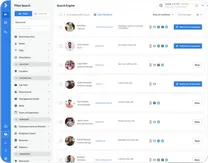
Finding those elusive property owners just got easier!
Skip tracing in real estate can be a real headache. Expensive services ($500 or more), iffy data, and hours spent searching leave many beginners feeling lost.
But here’s the good news: there are better ways!
This guide will walk you through everything you need to know about skip tracing, from the basics to advanced strategies. We’ll cover:
- Affordable options: Skip expensive services and find cost-effective ways to get started.
- Saving you time: Learn efficient methods to tackle even large property lists.
- Beyond the basics: Find advanced techniques like social media searches to find those hidden real estate gems.
Skip tracing isn’t just about phone numbers – it’s about uncovering valuable contact details. By the end of this guide, you’ll be a skip tracing pro, ready to connect with property owners and unlock new real estate opportunities!
What is Skip Tracing in Real Estate?
Skip tracing is the process for tracking down the contact details of difficult-to-find property owners in real estate. It’s a popular tool among investors looking for potential buying opportunities.
This technique is important if you’re an investor or a real estate professional who wants to reach out to property owners who might not be on the market but could be persuaded to sell. Skip tracing taps into public records, online databases, and other resources to uncover up-to-date contact information.
It’s particularly effective for finding owners of distressed properties or those in pre-foreclosure, opening doors to profitable investment chances.
What is Batch Skip Tracing?
Batch skip tracing is a method for finding multiple people’s contact details at once. It’s especially useful in fields like real estate and debt collection, where you need to reach many people quickly.
This technique involves analyzing large amounts of data to locate phone numbers, addresses, and other essential contact information.
By accessing various databases and public records, batch skip tracing simplifies your outreach efforts, allowing you to handle many queries simultaneously and save time.
Why Skip Tracing is Important for Real Estate Professionals?
Skip tracing is a key practice for you as a real estate professional. Here’s why it matters:
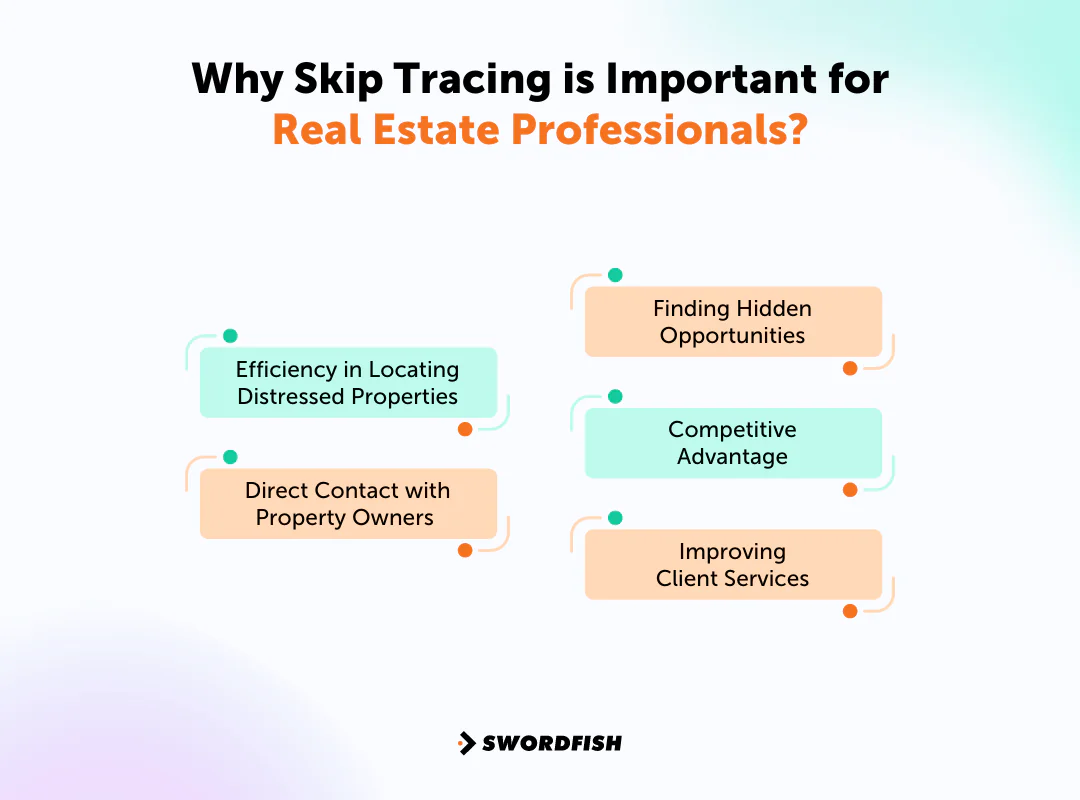
Efficiency in Locating Distressed Properties
Skip tracing helps you find distressed properties or owners behind on payments who might be open to quick sales. This allows you to act fast and secure properties at a lower cost before they hit the market.
Direct Contact with Property Owners
It enables you to directly contact property owners who might consider selling but haven’t listed their property yet. This direct approach can lead to quicker, more personalized negotiations, often more favorable than typical market transactions.
Finding Hidden Opportunities
Skip tracing helps you identify properties not listed on the market, uncovering valuable investment opportunities that others might miss. You can get ahead of the competition and secure deals that are off the radar.
Competitive Advantage
Using skip tracing gives you a competitive edge over others who rely only on traditional methods. This advanced approach ensures you have access to a wider range of potential deals.
Improving Client Services
You can provide better service to your clients by finding more property options and potential deals that meet their specific investment criteria. This not only enhances client satisfaction but also boosts your reputation in the real estate market.
How Does Skip Tracing Work?
Skip tracing is used to locate someone who has gone missing or is hiding. Here’s how it works:
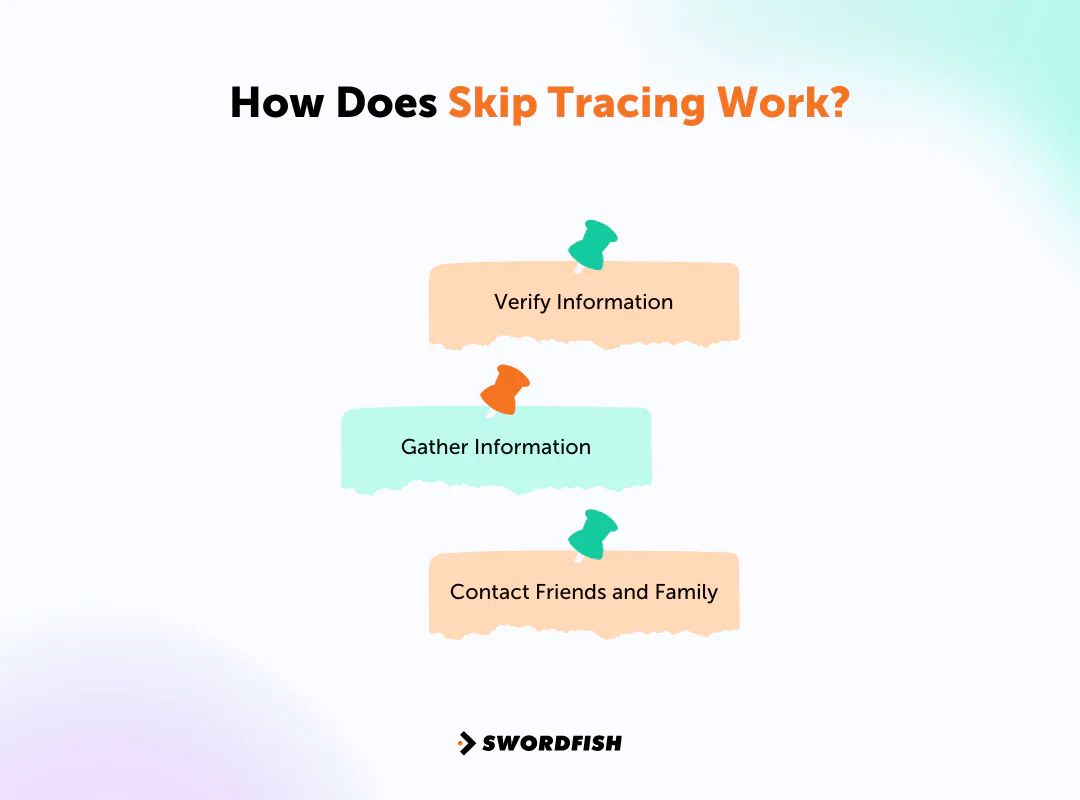
Verify Information
The skip tracer starts by checking the accuracy of any existing contact details, such as addresses, phone numbers, and emails. This step ensures you aren’t working with outdated information. Accurate data can quickly lead you to the person you’re seeking.
Gather Information
If initial details are outdated, the skip tracer digs into public records, databases, and online sources. They collect information from address history, court records, employment details, and social media. This helps them build a profile and locate the person.
Contact Friends and Family
The skip tracer may also reach out to the person’s acquaintances. Friends and family might provide hints about the person’s location. Ethical tracers use these connections to gather information without harassment.
How to Use Skip Tracing to Find Property Owners
Using skip tracing to find property owners requires diligence and resourcefulness. Here’s how you can effectively implement this technique:
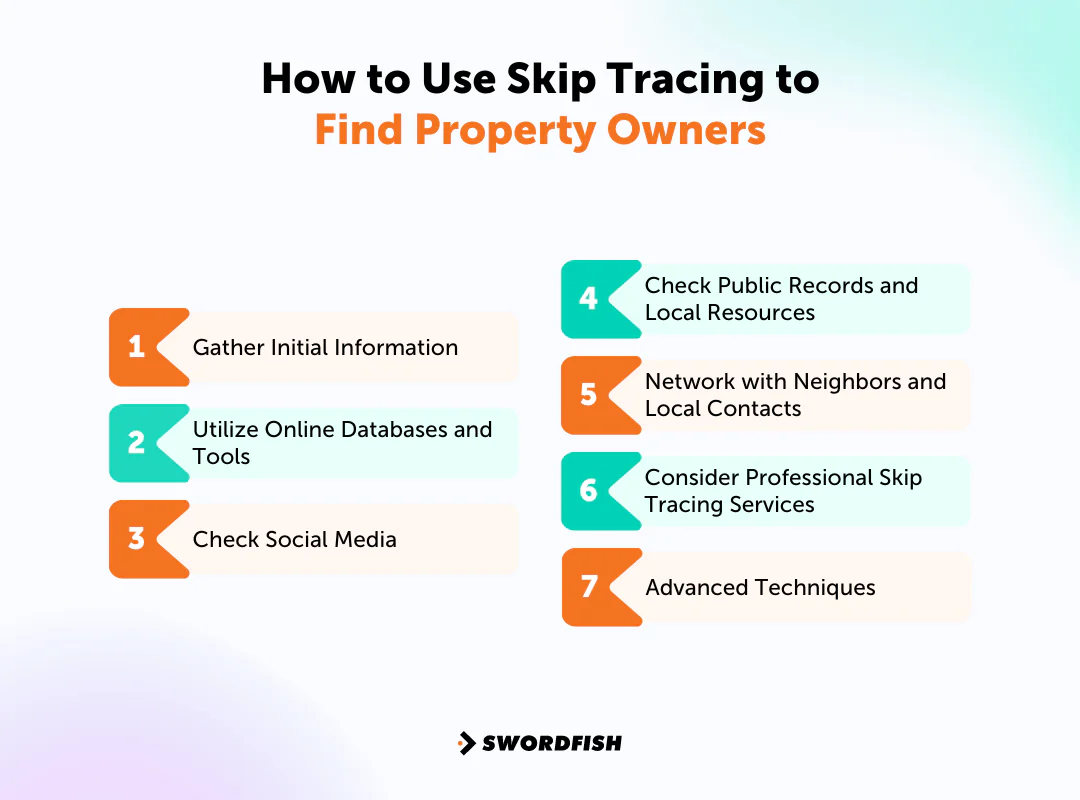
1. Gather Initial Information
The more details you have about the owner and the property, the easier your search will be.
Start with public records like property tax documents, voter registration, or anything from your local government. These are often free and a good starting point.
Look for any past addresses or interactions the owner might have had with utilities or public agencies – these can offer valuable clues.
2. Utilize Online Databases and Tools
You can use online databases and professional skip tracing tools that are specifically designed for real estate needs.
Skip tracing services like Swordfish AI offer extensive databases with up-to-date contact information, such as emails and phone numbers. These can be a real timesaver, but they usually require a paid subscription.
Do your research and choose a service that fits your needs – consider cost, ease of use, and the type of information they provide.
3. Check Social Media
Social media platforms are full of information. People share a lot online!
Check platforms like Facebook, LinkedIn, and Instagram for the owner or someone who might know them. You might find direct contact details or clues like new locations, employers, or even mutual connections to help you reach the owner.
Always respect privacy and ethical guidelines when using social media to skip tracing.
4. Check Public Records and Local Resources
Your local county assessor’s office is a goldmine of information. Property records often include the owner’s name and past contact details.
Court records can also be helpful, revealing legal proceedings involving the property that might shed light on the owner’s situation.
Many areas allow you to access these records online, but depending on local regulations, you might need to visit the office in person.
5. Network with Neighbors and Local Contacts
Neighbors can be a great source of information. They might know firsthand the owner’s whereabouts, recent moves, or contact details. Be professional and respectful when approaching them.
This can help you find the owner directly and build relationships with locals who might be valuable resources in the future.
6. Consider Professional Skip Tracing Services
If you’re running out of time or hitting a dead end, professional skip tracers can be a good option. They have access to exclusive databases and the expertise to use them effectively.
This comes at an extra cost, but for complex cases or high-value properties, a professional’s efficiency and speed can be worth it.
7. Advanced Techniques
- Mailing and Forwarding Addresses: Check if the owner has a forwarding address with USPS or use services like FedEx or UPS for better engagement.
- Google Searches: Perform online searches to gather more information about the owner. This can lead to finding relatives or associates.
- Genealogy Websites: Use sites like Ancestry.com to trace family trees and find relatives who might have information about the owner.
- Private Investigators: Consider hiring a private investigator who can access specialized skip tracing services and secure databases for deeper insights.
Who Can Use Skip Tracers & Skip Tracing Services?
If you’re looking for a way to locate people for various professional reasons, skip tracing services can be invaluable. Here’s how you might use these services across different professions:
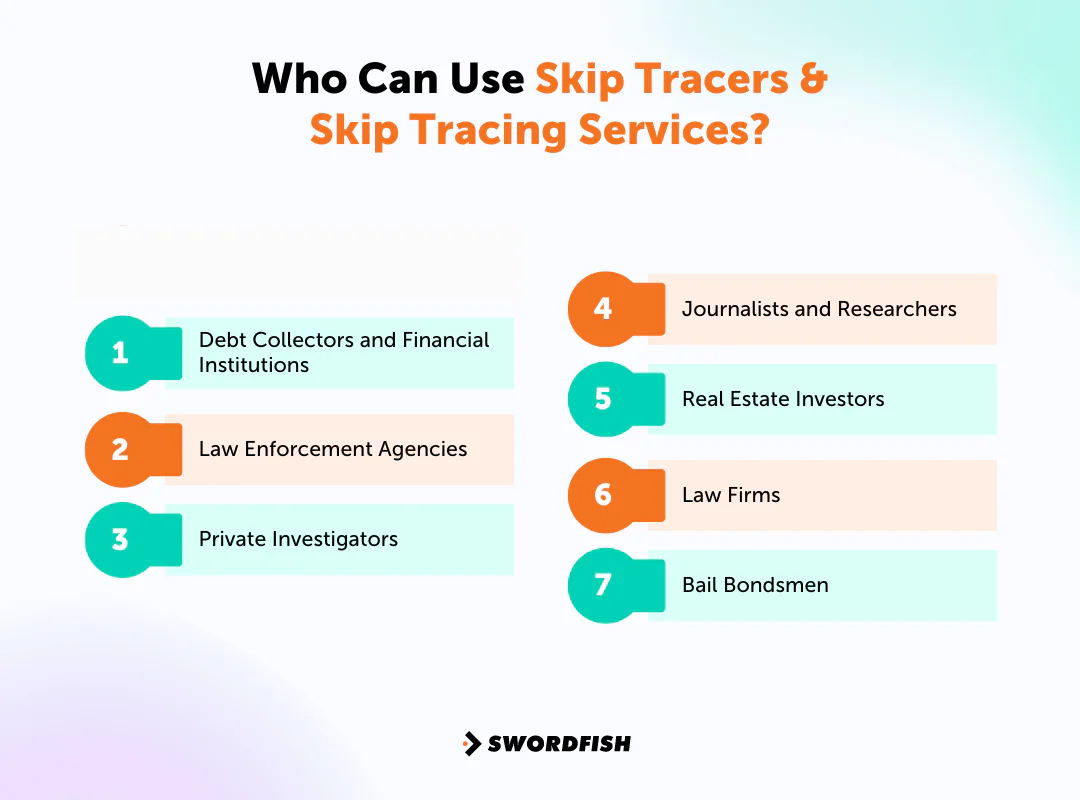
Debt Collectors and Financial Institutions
If you’re trying to recover unpaid debts and can’t find the debtor, skip tracing can help you track down their current contact details to collect what’s owed. This method improves your chances of successful debt recovery by providing accurate and updated information.
Law Enforcement Agencies
As a law enforcement official, you can use skip tracing to find missing persons or individuals involved in legal cases, helping you serve legal documents or summonses effectively. This tool is essential for maintaining public safety and ensuring justice is served.
Private Investigators
If you’re a private investigator, skip tracing is a tool you can use to gather crucial information in personal or legal matters such as divorce, custody battles, or locating missing persons.
Access to extensive databases can provide you with the needed location and contact details, enhancing your ability to serve clients effectively.
Journalists and Researchers
If you’re a journalist or researcher, skip tracing can help you connect with hard-to-find sources who have valuable insights or testimonies for your stories or research projects, especially in investigative work. It enables you to uncover hidden stories and bring critical information to light.
Real Estate Investors
As a real estate investor, skip tracing can help you identify property owners interested in selling, particularly those not actively on the market, allowing for direct negotiations. It’s important for discovering under-the-radar investment opportunities that can yield high returns.
Law Firms
If you work at a law firm, you can use skip tracing to locate individuals needed in legal proceedings or to be served with legal papers, ensuring the legal process proceeds smoothly. This method is key to behold the integrity of the legal system and ensure that all parties are accountable.
Bail Bondsmen
If you’re a bail bondsman, skip tracing helps you track down people who have skipped bail. This is important to make sure they show up in court as required. It protects your business from losing money and keeps the bail system effective.
When Should You Skip Trace a Home or Property Owner?
Skip tracing a home or property owner is useful in several situations. Here are some scenarios when it’s particularly beneficial to use this method:
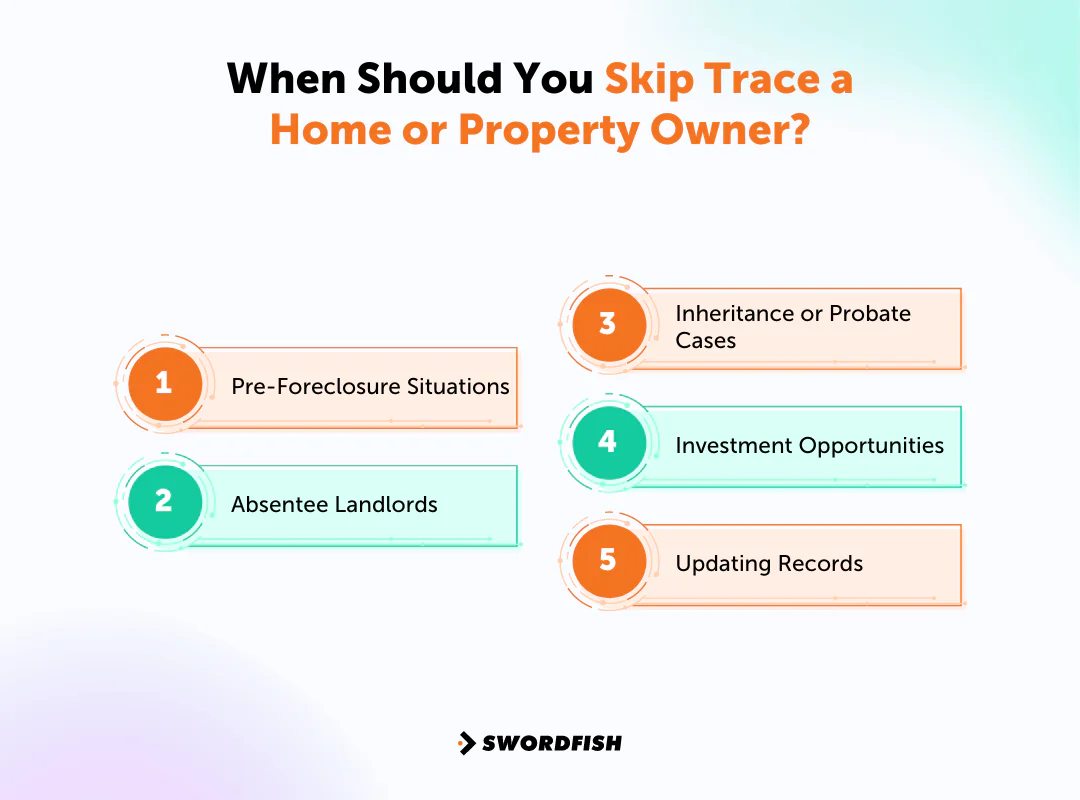
Pre-Foreclosure Situations
If a property is approaching foreclosure due to unpaid debts, skip tracing can help locate the owner to discuss possible solutions or negotiate a sale. This allows for potential agreements that could prevent foreclosure and financial loss for both parties.
Absentee Landlords
When property owners are not on-site or are difficult to contact, skip tracing can provide current contact information. Real estate agents and property managers often use this method to address issues like lease violations or maintenance concerns.
Inheritance or Probate Cases
If you’re dealing with a property that’s been inherited or is part of a probate process, it’s crucial to find the rightful heirs or owners. Skip tracing can help you, as a lawyer or estate executor, contact these individuals to ensure the estate is settled properly according to the law.
Investment Opportunities
Real estate investors looking for opportunities in off-market properties use skip tracing to contact owners directly. This can lead to private negotiations and potentially lucrative investment deals without the competitive bidding of the open market.
Updating Records
If you need to keep owner information current for legal, tax, or regulatory reasons, skip tracing is a valuable tool. Whether you work in a government agency or a business, you can use skip tracing to update records.
DIY Skip Tracing Methods and Tips for Real Estate
When you’re in real estate and need to find property owners, skip tracing can be done on your own. Here are some DIY skip tracing techniques:
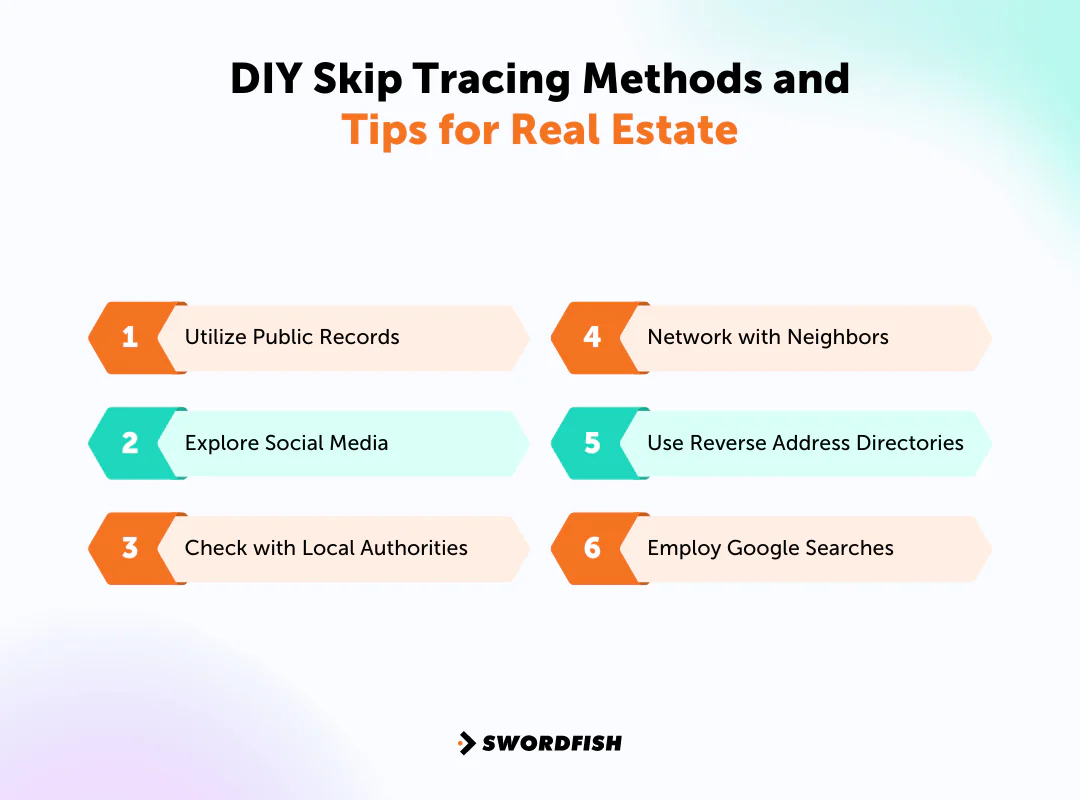
Utilize Public Records
Start by searching public records like property tax information, voter registrations, and court records. These resources are often available online and can provide you with current addresses or property ownership details.
Explore Social Media
Social media platforms can be really helpful for locating property owners. Look through profiles on Facebook, LinkedIn, or Instagram. People sometimes share contact information or details about properties they own.
Check with Local Authorities
Visit or call your local courthouse or tax assessor’s office. They can offer insights into the latest property transactions and owner information. This is especially useful if online records are not up-to-date.
Network with Neighbors
If you’re looking into a specific property, consider talking to neighbors. They might have current contact information or know the whereabouts of the property owner. This method can also reveal useful insights about the property’s condition and history.
Use Reverse Address Directories
Online directories can help you trace phone numbers or emails associated with a property address. Sites like Whitepages or Spokeo let you enter an address to find linked contact details, although they might require a small fee.
Employ Google Searches
Don’t underestimate the power of a simple Google search. Type in the property address or the owner’s name if you have it. You might find business registrations, personal blogs, or other leads that could point to the owner’s current contact details.
When Should You Hire a Skip Tracer?
Sometimes, tracking down a person or property owner requires more than just DIY efforts. Here are situations where you might need to hire a skip tracer:
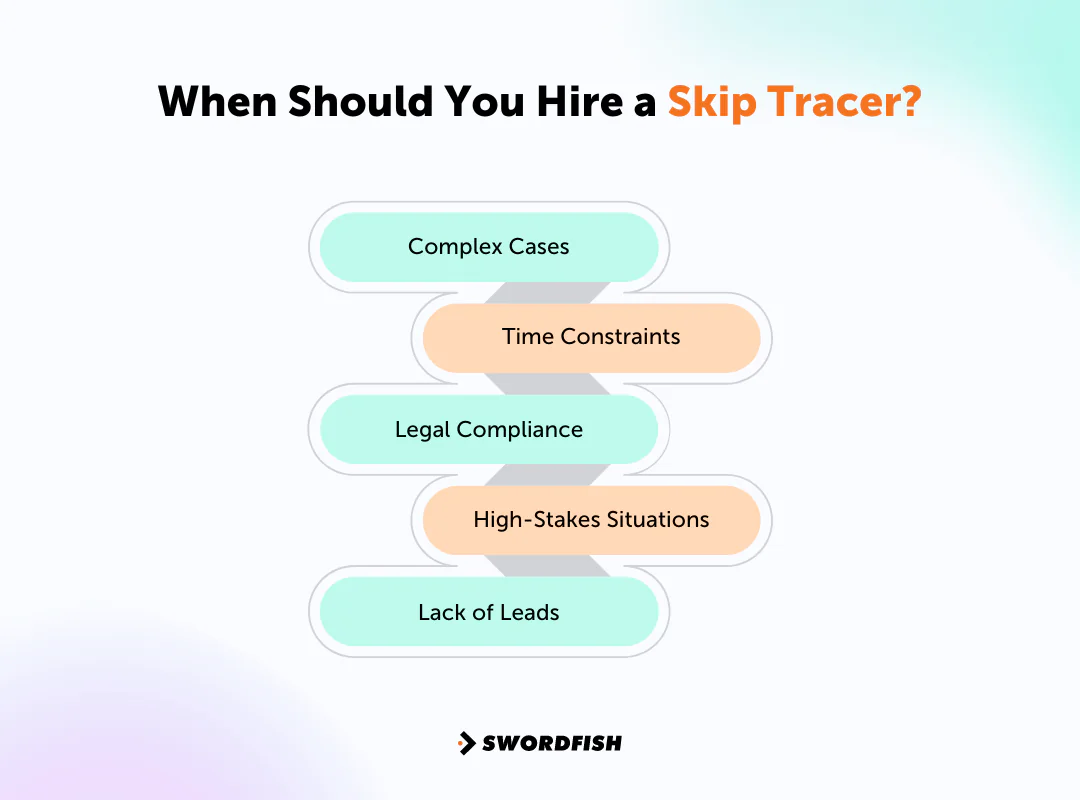
Complex Cases
If you’ve tried DIY methods and still can’t find the person you’re looking for, it might be time to hire a professional skip tracer. They have access to more extensive databases and tools that can handle complex searches effectively.
Time Constraints
When you’re under a tight deadline, such as needing to serve legal papers or finalize a deal, hiring a skip tracer can save you valuable time. They can provide faster results due to their expertise and resources.
Legal Compliance
If the information you need touches on sensitive or legal matters, a professional skip tracer ensures that all data collection is done in compliance with the law. This is crucial to avoid any legal repercussions for improper data handling.
High-Stakes Situations
In high-stakes scenarios like debt collection or major investments, having accurate and timely information is critical. A skip tracer can provide reliable data that helps you make informed decisions and mitigate risks.
Lack of Leads
If your initial search yields no leads or the information seems outdated, a skip tracer can delve deeper. They often uncover connections and details that are not obvious or accessible through public records.
How Much Does Skip Tracing Cost?
Skip tracing costs can vary a lot depending on how complex and extensive your search needs to be. Here’s a quick rundown of what you might expect to pay:
- Initial Search Cost: Typically, the starting price for basic skip tracing services usually ranges from $250 to $500. This flat fee covers a straightforward search with some limits on the information provided.
- Advanced Search Cost: For difficult cases where the person is harder to find, skip tracing might be charged by the hour. Hourly rates typically fall between $95 and $200, and you should plan to spend at least $1,500 to get started.
- Batch Skip Tracing Cost: If you’re looking to track down multiple people, batch skip tracing costs between $0.10 and $3 per record. This option is more budget-friendly for large-scale searches.
- Professional Resources: Professional skip tracers use special resources and databases that aren’t available to the general public. These tools increase the likelihood of successfully locating someone.
What are the Best Skip Tracing Tools for Real Estate?
Choosing the right skip tracing tools can be challenging with so many options available. Here are the top three tools that stand out for their accuracy, ease of use, and comprehensive property and owner information:
Swordfish AI
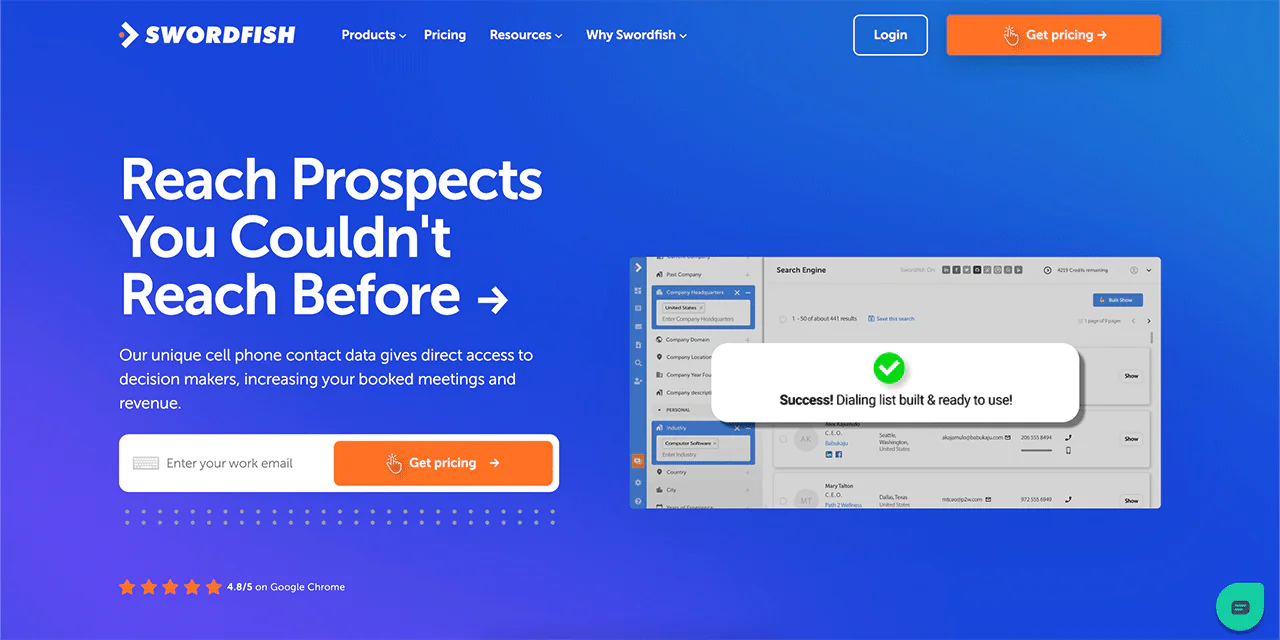
Swordfish AI stands out as one of the best skip tracing tools for real estate, equipped with a massive database of over 3.5 billion profiles. This gives you an expansive pool of information to dive into as you search for property owners.
Notably, Swordfish AI provides phone numbers that are 33% more and 45% more accurate than those offered by competitors. Thus ensuring that the contact details you access are reliable.
Additionally, Swordfish AI features user-friendly interfaces and real-time data updates, making your skip tracing efforts smoother and more efficient. The tool also integrates easily with other platforms, enhancing your ability to manage and organize data effectively.
With Swordfish AI, you’re equipped to find and connect with property owners quickly, improving your chances of securing great real estate deals.
Features of Swordfish AI
Here are the features of Swordfish:
Prospect Search
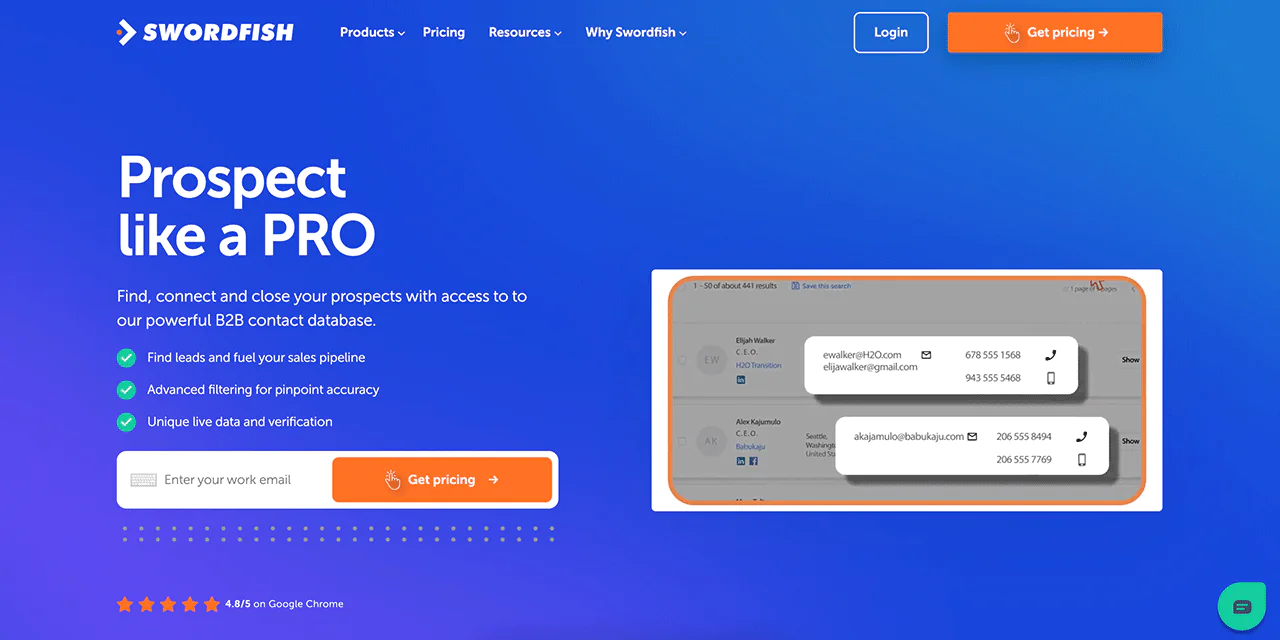
Use Swordfish AI’s Prospector Search to quickly find property owners by entering basic information. It searches its vast database to give you detailed profiles, helping you pinpoint potential sellers efficiently.
Chrome Extension

The Chrome Extension lets you gather contact information directly from your web browser while browsing online property records or LinkedIn profiles. This means less switching between applications and faster access to owner details.
Enrich Files
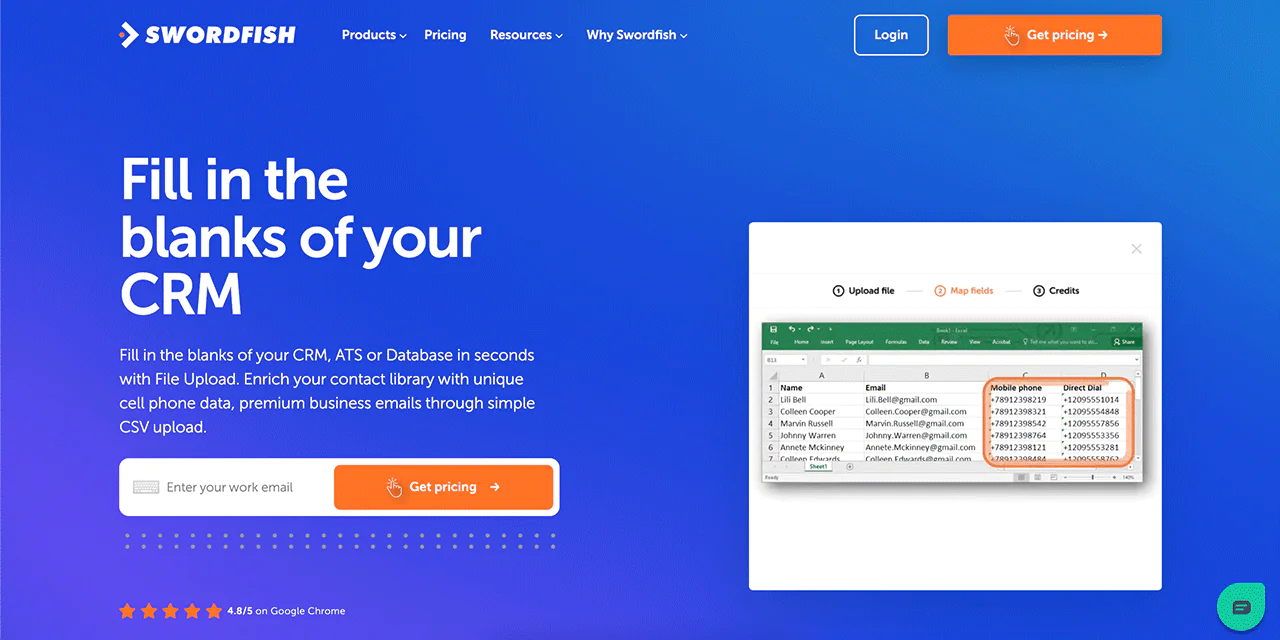
Upload a list of partial contacts, and the Enrich Files feature will fill in the missing details, like phone numbers or email address. This saves you time and enhances your list with accurate, actionable contact information.
Reverse Lookup
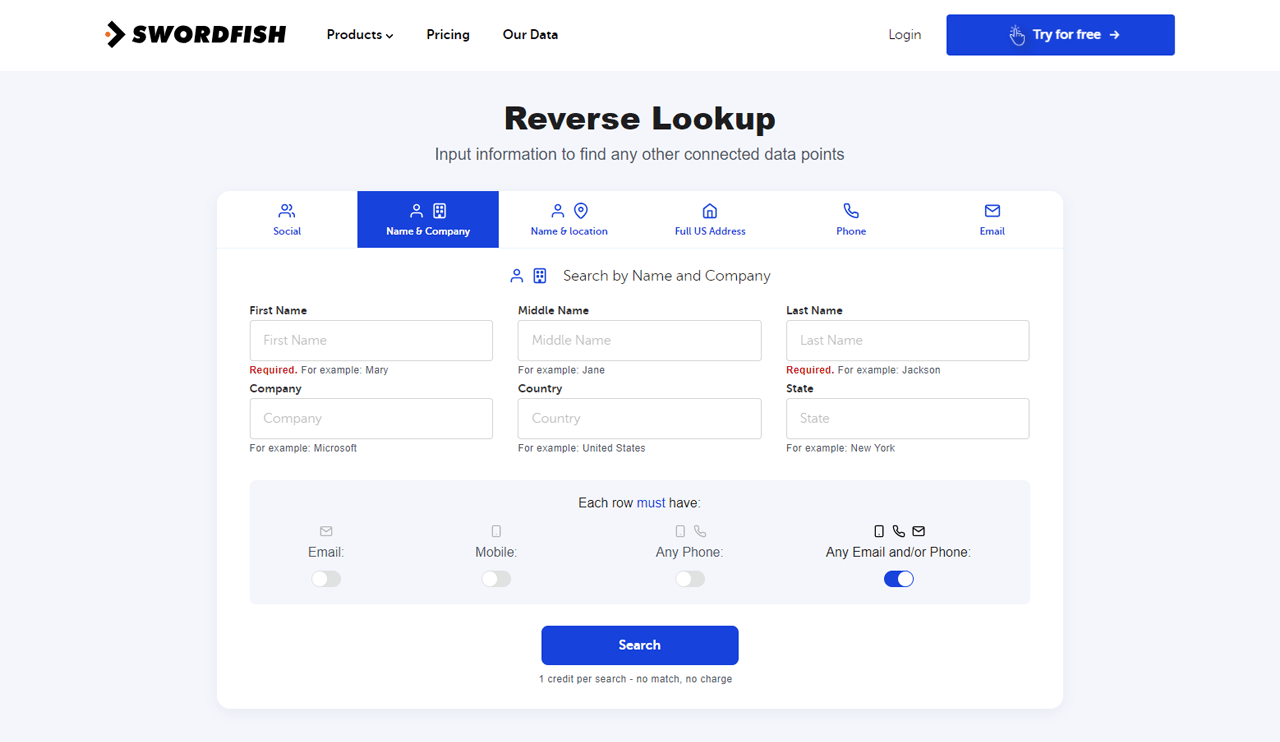
If you have phone numbers and email addresses, Swordfish AI’s Reverse Search can reveal the owner’s full name and additional contact information. This is ideal for confirming the identity of property owners or finding alternative ways to reach them.
API Integration
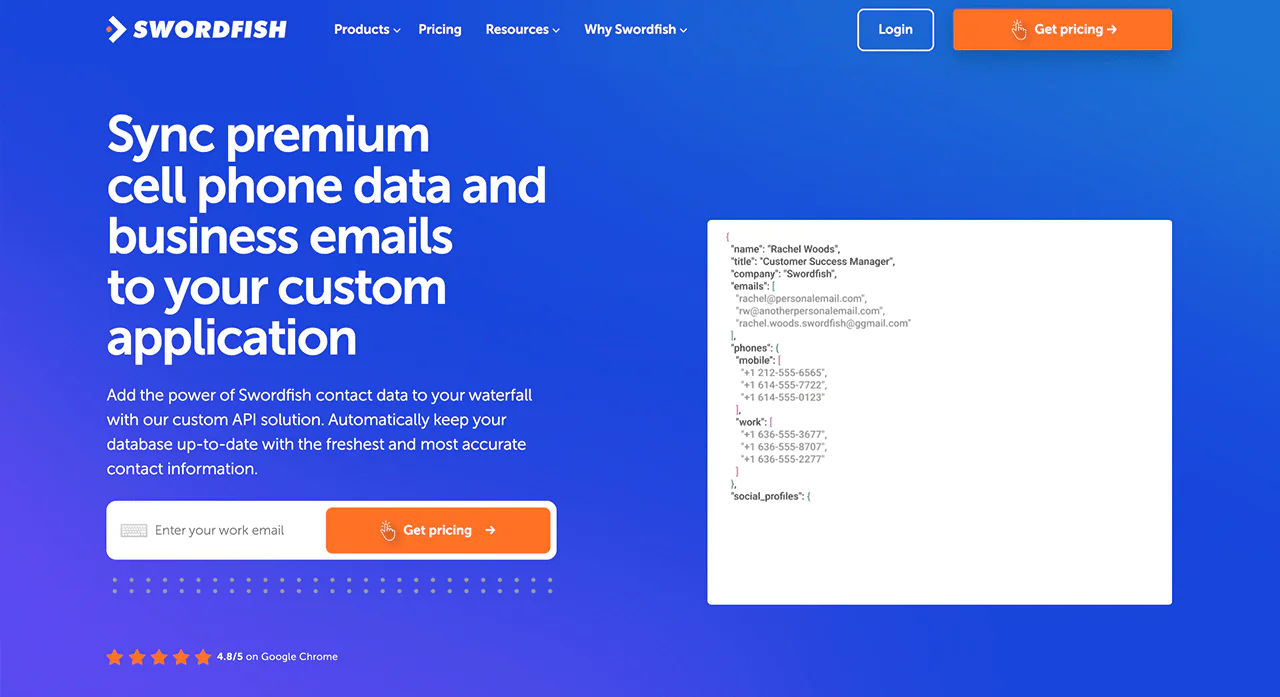
Integrate Swordfish AI with your existing CRM or other management systems for seamless data flow with API Integration. This keeps your skip tracing efforts organized and efficient, allowing you to update and access owner information directly within your usual workflow.
Bombora Intent Data
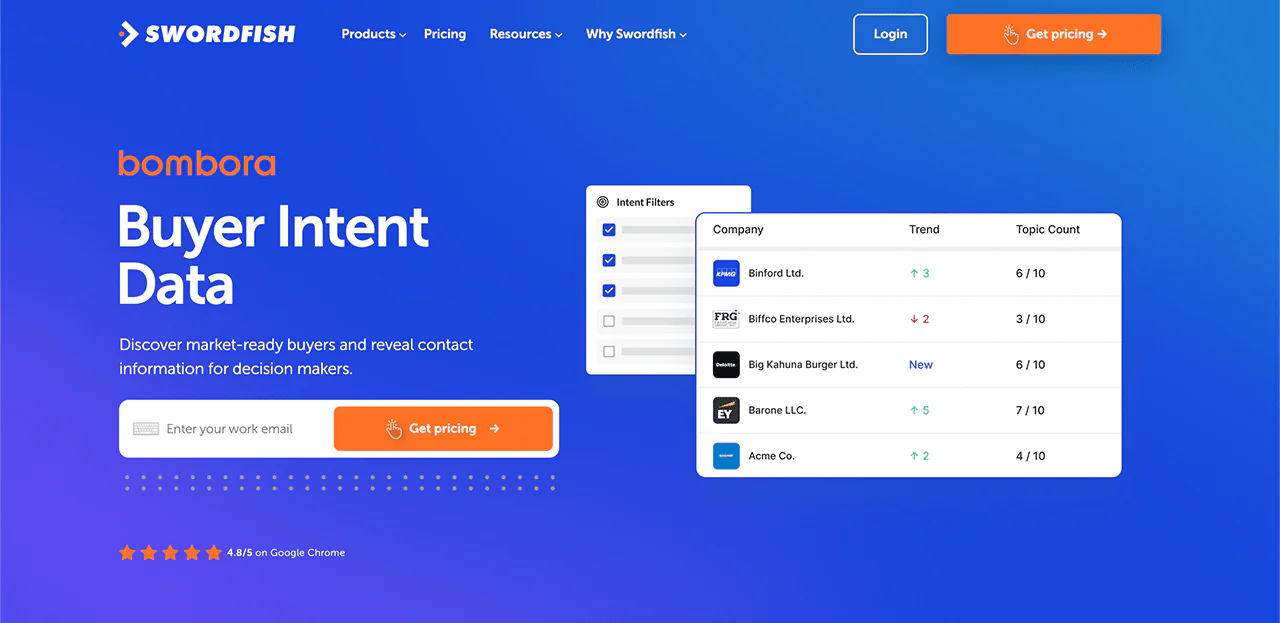
The Bombora Intent Data feature offers insights into property owners’ market behaviors, helping you identify those who might be gearing up to sell. Understanding their intent can guide you to the right prospects at the right time, increasing your chances of making successful contact.
Try Swordfish Ai
Skip Genie

Skip Genie is your go-to for fast and effective property owner searches. Just enter names or addresses, and it delivers detailed contact info, like emails and phone numbers.
Ideal for real estate investors and professionals, its user-friendly interface and strong data sources make it a top pick for enhancing your deal-finding capabilities.
Key Features of Skip Genie
Here are some key features of Skip Genie:
- Instant Data Access: Get immediate access to important data, allowing you to quickly connect with property owners and speed up transactions.
- Bulk Search Option: If you’re working with multiple properties, you can upload a list and receive detailed reports fast, which helps with handling large amounts of data efficiently.
- Easy-to-Use Interface: Skip Genie’s design is straightforward, making it easy to use, even if you’re not tech-savvy.
- Educational Support: Along with its tools, Skip Genie also offers educational resources and coaching to help you improve your skills in real estate investing.
- Affordable Pricing: Skip Genie offers various pricing plans that provide good value and fit different budgets and needs.
PropStream
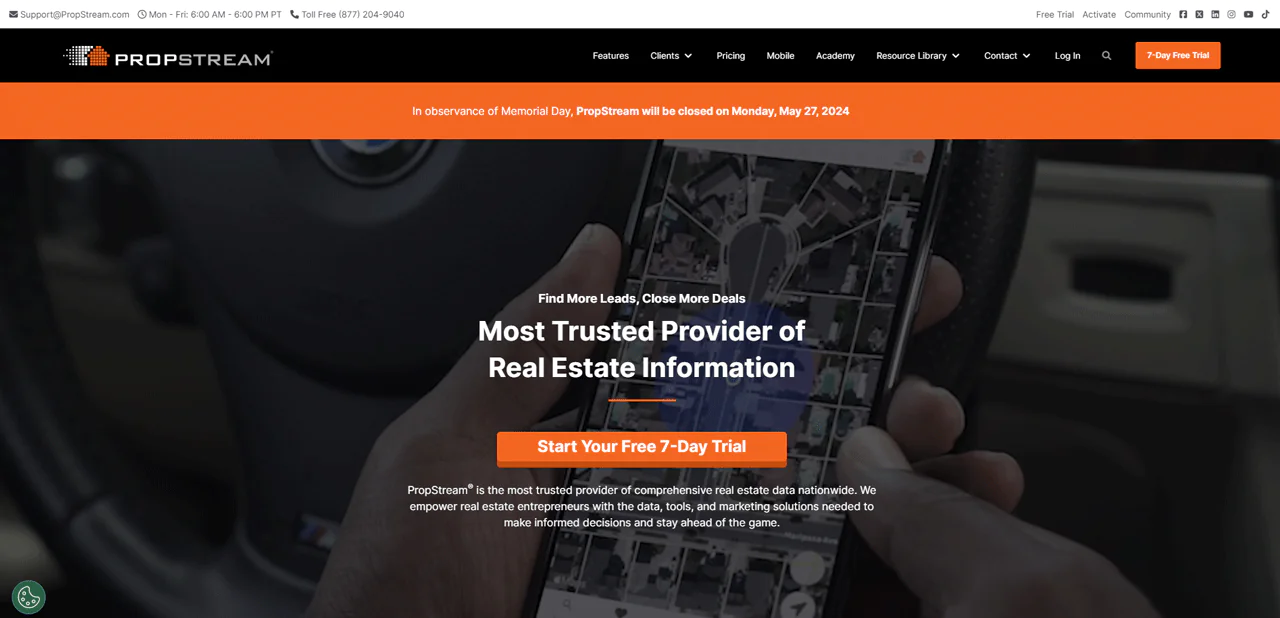
PropStream is your top choice for reliable skip tracing tools. It’s an all-in-one solution that makes finding property owners’ contact details straightforward.
With years of experience and a skilled data team, PropStream is a trusted name in real estate. Its extensive nationwide data ensures you get accurate information.
Real estate professionals use PropStream for millions of skip traces each month, making it easier to contact owners quickly.
Key Features of PropStream
Here are the key features of PropStream:
- Expert Data Accuracy: With over fifteen years of data expertise, PropStream provides highly accurate information, earning the trust of real estate professionals.
- Nationwide Data Coverage: PropStream offers an extensive, regularly updated database covering the entire U.S., giving you access to the latest information.
- Intuitive Interface: PropStream’s user-friendly interface allows easy navigation and effective use of its features, boosting your productivity.
- Speed and Efficiency: The platform is designed for quick data retrieval, helping you find owner contact details fast and streamline communication.
- Comprehensive Real Estate Tools: PropStream combines skip tracing with other essential tools in one seamless platform, simplifying your workflow.
Conclusion
Throughout this guide, we’ve explored the fundamentals of skip tracing for real estate, discussing various techniques and tools used to locate property owners.
Skip tracing is important for real estate investors because it helps uncover opportunities that are not readily visible, giving them a competitive edge in finding deals.
Among the different skip tracing services for real estate, Swordfish AI stands out as the best. Its accuracy, ease of use, and comprehensive database make it a top choice to simplify the property search process efficiently.
Frequently Asked Questions
Where can I find data for skip tracing?
Data for skip tracing can be accessed through public records, online databases, credit bureaus, and various private information providers. These sources compile extensive contact details and other relevant information useful for locating property owners.
Can skip tracing help you buy foreclosed properties?
Yes, it can help locate owners of foreclosed properties who might still be open to selling their rights before an auction. This approach allows investors to make offers directly to property owners, potentially securing properties under market value.
What is the difference between skip tracing and background checks?
Skip tracing focuses on locating a person’s contact details to facilitate communication, primarily used in real estate and debt collection. In contrast, background checks provide a more detailed view of an individual’s history, including criminal records, employment history, and financial status.


 View Products
View Products


